You’ve just started your fitness email list.
You can see the number of subscribers racking up.
You’re excited.
But there’s a question bugging you: “what should I send?”
Coming up with ideas for email marketing campaigns is tricky; you know you need to send something, but you’re worried about sending the wrong thing.
That’s where this article comes in.
I’m going to show you everything you need to know about crafting fitness email campaigns. From what a campaign is, to the anatomy of a healthy email, and specific emails you can send.
Let’s get started…
What Is An Email Campaign?
An email campaign is any type of email message you send to your customers. It could be a quick update, your weekly newsletter, or a 10-part email series: all of them are campaigns!
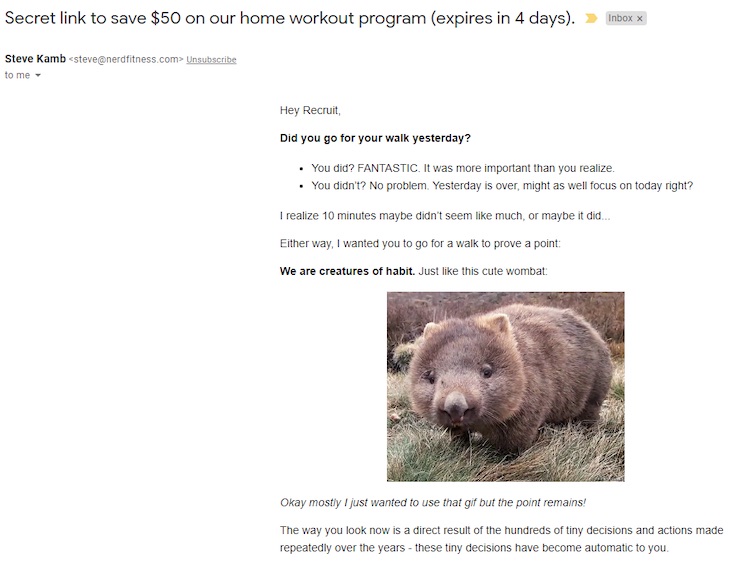
Your campaign should aim to hit a combination of these three goals:
- Engage: create a stronger connection with the reader.
- Educate: impart knowledge to the reader.
- Entertain: be enjoyable for the reader.
Email campaigns are your opportunity to show what sets you apart; to showcase your skills, promote your products, and build long-lasting relationships.
How often you create and send email campaigns will be dictated by your audience. Industry data suggests once a week is a good starting point, as this gets high open rates and link clicks.
You’ll need to spend some time testing frequencies to see how your audience responds to find your sweet spot. But, if you get the balance right, you’ll start to see responses like this:

In the rest of this guide, I’m going to show you exactly what you need to know to send high-quality email campaigns that will build a strong, healthy, and active email list.
Let’s go…
The Anatomy Of A Healthy Email Campaign
Think of writing an email like writing a training program: it must be unique enough to fit the individual, but built on a strong foundation of principles.
The same applies to email marketing!
Although the campaigns you send out will be unique, they’ll all be built on tried-and-tested principles that ensure your audience will be happy to receive them.
There are three elements that make-up each email campaign:
- Purpose: campaigns need a clear “why”
- Personality: campaigns should be reader-focused
- Accuracy: campaigns should be error-free
Here are each of those elements in more detail.
Purpose – Your Campaign’s “Why”
Your email campaign needs a clear purpose.
You need to fully understand why you’re sending the email. And, it must make sense to the reader that your email has landed in their inbox.
Ask yourself three questions before you start to write:
- What do I want to say with this email?
- What should the reader take from this email?
- Is this in line with my fitness brand?
These will make writing your emails much easier, and help you to choose the most impactful content ideas for your readers.
Take a look at this email I received from MyFitnessPal:
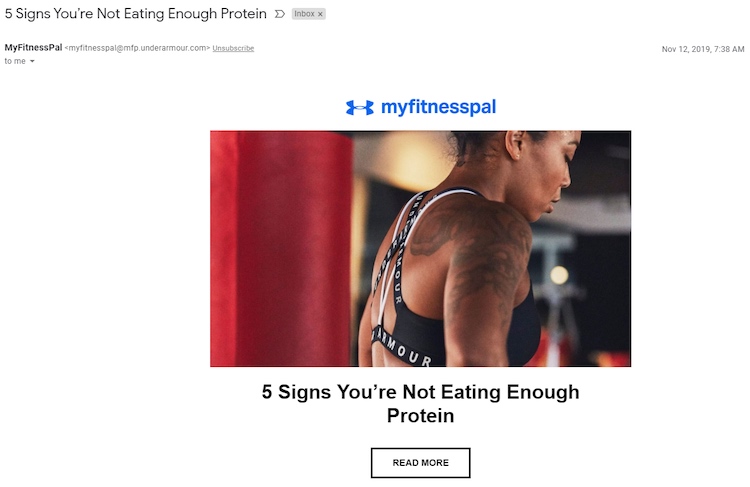
They answered all three of these questions before sending the email. It has a clear purpose, and makes sense to me as a reader:
- The email alerts me to new content.
- It gives me an actionable guide to help my nutrition.
- The topic is relevant to why I use their app.
This is the kind of email I’m happy to get in my inbox. (On the flip side, if they started sending me tips about how to play the harmonica I’d be hitting unsubscribe pretty quickly.)
Here is a great video from Simon Sinek on why it’s important to Start With Why:
Personality – Your Campaigns Should Be User-Focused
I’d like you to think of personality in two ways:
- Your personality should shine through.
- Your emails should be personalized to each reader.
You’ll want to write your emails in a way that shows off your personality and humanizes them. This applies to both personal brands and product-driven brands.
Personality is important in email marketing because people will unsubscribe if the content is boring. In fact, it’s the most common reason people stop following email lists!
It might be your incentive that gets people onto your list, but it will be your personality that keeps them there. Yoga with Adriene lets her’s shine through brilliantly here:
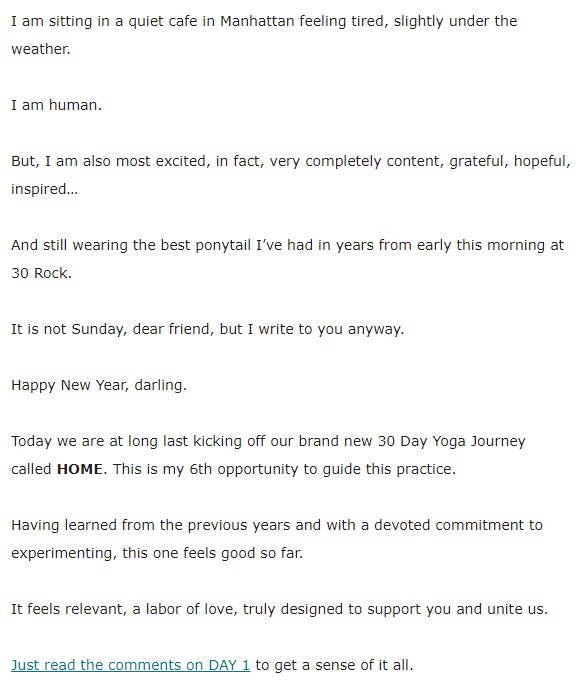
It’s also important to make the reader feel included in what you’re sending. This is where personalization comes in.
Email marketing platforms will let you include an individual subscriber’s name in each campaign. It’s a little tag that looks like this:
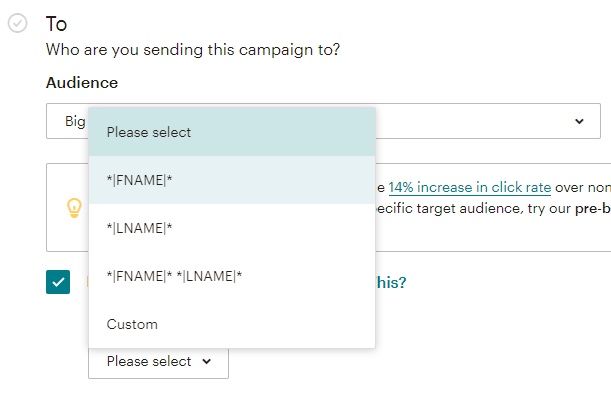
Even just adding a first name can have big results. Data shows emails personalized in this way can result in six times more transactions and are opened 5% more often!
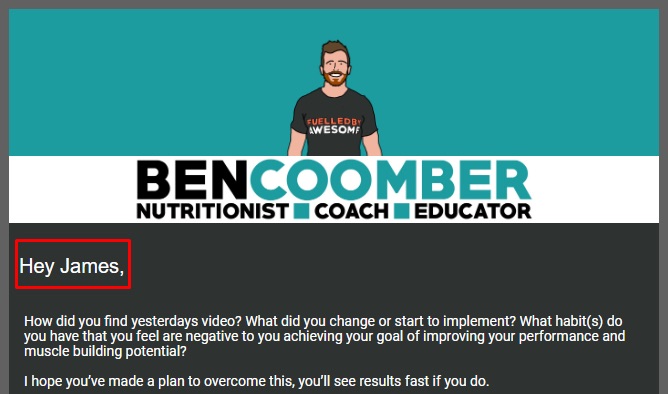
That’s why I wanted you to add the Name field to your sign up form in part one of this series. So, if you’re not asking for this information go back and add it now!
Accuracy – Your Campaign Should Be Error-Free
Proof-reading is your best friend.
You should ensure that your emails are as error-free as possible. You should go through and check your email contains:
- Personalization tags
- Correct spelling and grammar
- The subject line
- Working external links
- Images that load properly
I know this isn’t the most enjoyable part of writing an email. But, it will save you lots of headaches and lost subscribers in the long run.
Okay, with these foundations in place, we can look at the types of email marketing campaigns you should be sending.
The 5 Types Of Email Campaigns You Should Be Using
In this section, I’m going to show you five types of email campaigns you can start sending.
They are:
- Welcome emails
- Weekly newsletters
- Promotional emails
- Video series
- Seasonal emails
These will give you a kit-bag full of options to start working with and get the quickest marketing wins with your email list.
1. Welcome Emails
Welcome emails are automatically sent to new subscribers when they confirm their subscription. They’re the first piece of email marketing communication anyone is going to see from you!
Data shows that 74% of subscribers expect a welcome email and they’re opened 91.43% of the time. This makes them a powerful piece of marketing real estate!
Welcome emails are your opportunity to:
- Introduce yourself and your community.
- Provide links to your incentives.
- Talk about future content.
- Set expectations.
Steve Kamb does this expertly over at Nerd Fitness. He starts with a relevant subject line, followed by a brief introduction…
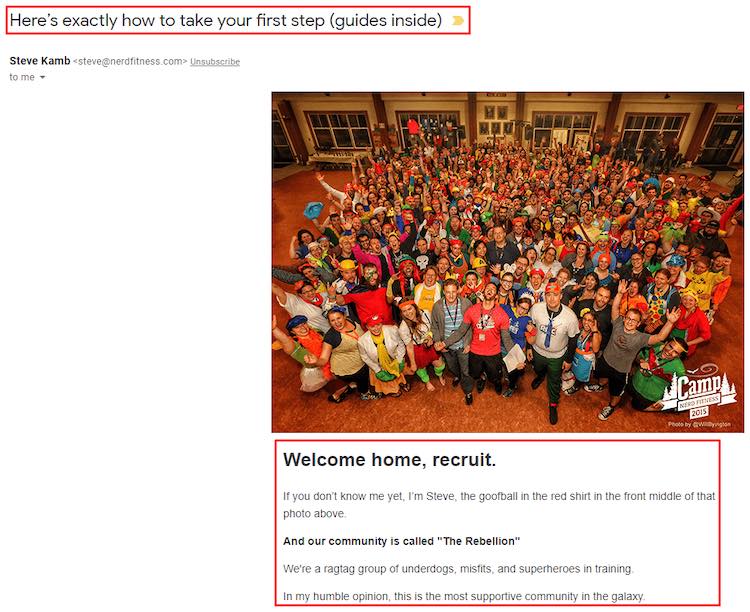
…then he gives them the guides they signed up for….
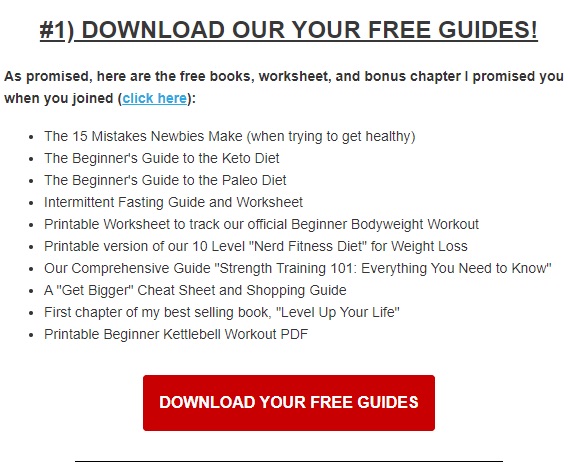
…before giving them a real-life look of what happens to people who join his email list:
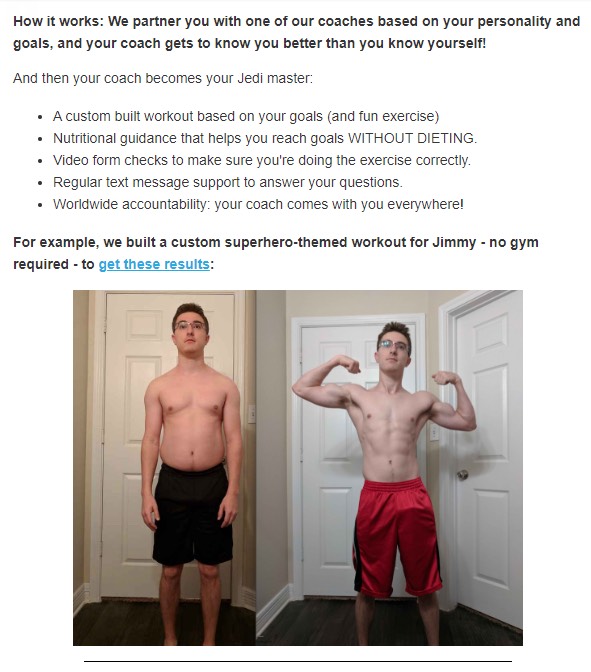
I highly recommend you go over and sign up for his list so you can see the email in full, and look at how you can create a similar welcome email for your list.
2. Weekly Newsletters
Weekly newsletters are the most common type of email. They’re standalone emails that look to deepen the connection with your audience.
I’m talking…
- news updates
- weekly roundups
- new content alerts
- industry-relevant links
…basically, anything that isn’t promotional.
Active Spaces is a company that looks to connect people with new and exciting places and ways to workout. Their weekly newsletter is often a roundup of new spaces they’ve found:
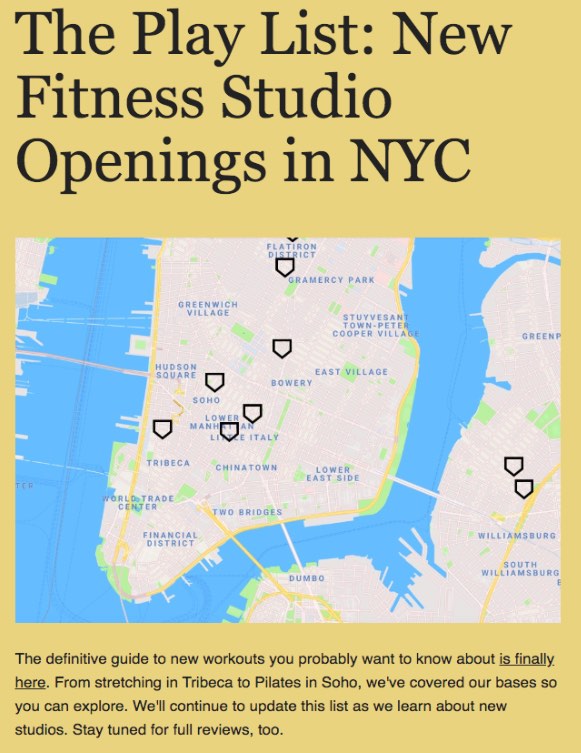
There’s nothing promotional there; just information their subscribers can start using right away!
Tim Ferriss, author of The Four Hour Body, has a slightly different approach. He created a newsletter called 5 Bullet Friday newsletter where he shares five key points from the week:
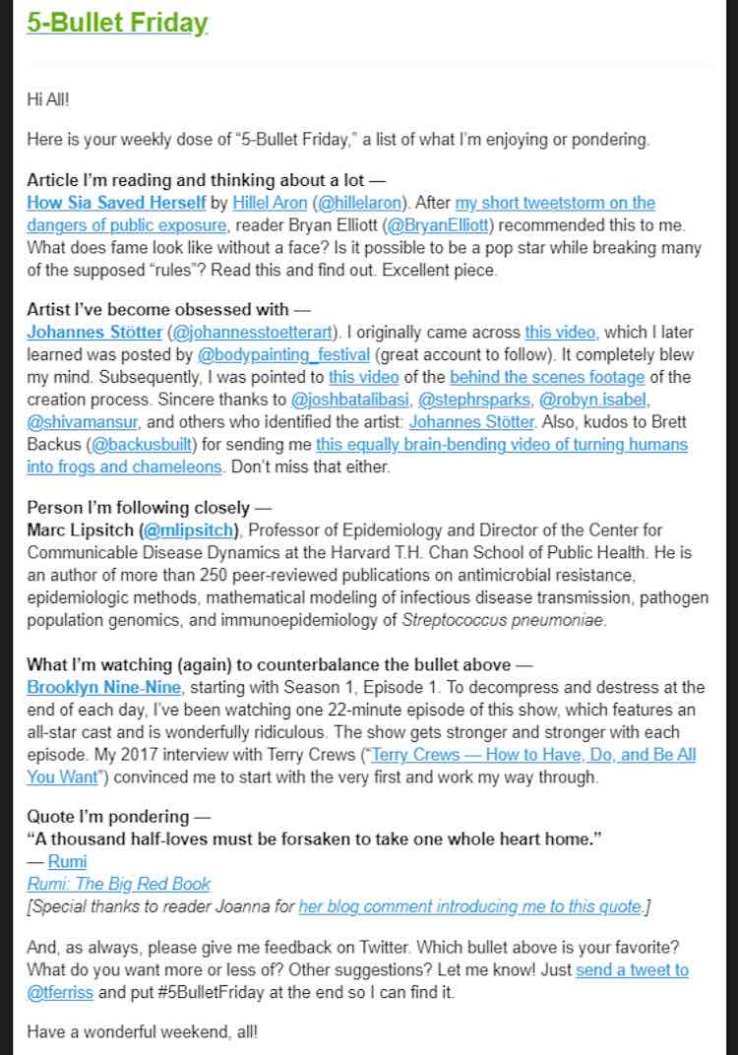
There is no right and wrong way to construct your newsletter. It just needs to be relevant to your industry and subscribers, while also providing a lot of value!
I’d recommend that weekly newsletters make up 80% of the content you send. At least at the early stages where you’re learning, testing, and growing everything on your list.
You can devote the other 20% to promotional emails.
Speaking of which…
3. Promotional Emails
Promotional emails are any email that promotes a product or service to your customers. These emails could be:
- Offers
- Sales
- Product launches
- Product updates
- Schedule openings
Basically, anything with the goal of generating income. Like this email from MyProtein:
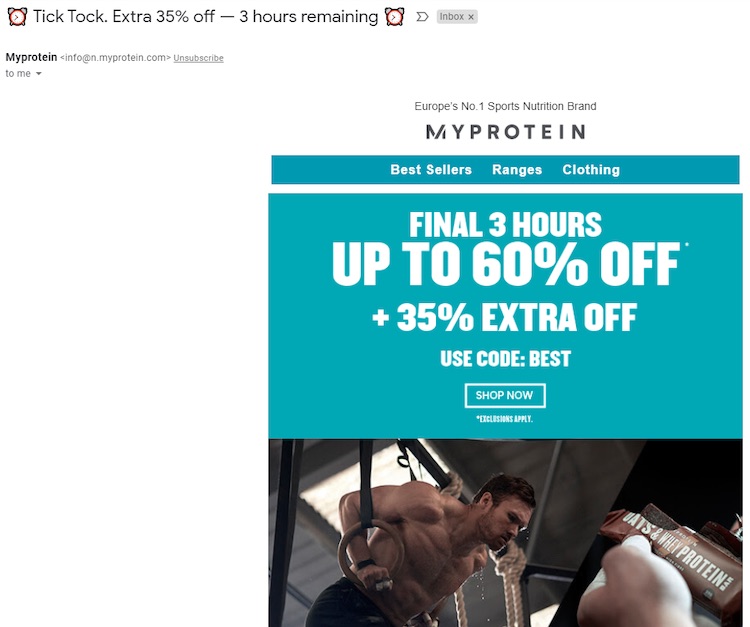
It’s common to worry about sending promotions emails to subscribers. If you’re like me, you’re usually worried everyone will unsubscribe and hate you for pitching anything.
But, that’s not the case! Subscribers expect to receive your promotional emails. In fact, 49% of subscribers say they actively want to receive promotional emails. Just don’t overdo it.
4. Video Series
This might come as a surprise but: videos make for great emails!
Subscribers love getting videos in their emails, and the result of doing so can be great. It’s been shown that including videos can lead to a:
I recommend you include video as part of a longer series of emails, where users receive a video once a day (or every few days) breaking down a larger topic.
For example…
You could tie this into your welcome series like nutritionist Ben Coomber does. He sends out a daily video as part of his 5 Day Muscle Building Challenge:
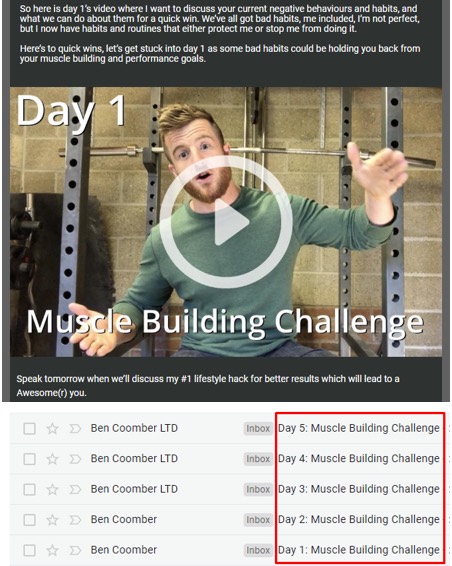
You can also make this a completely standalone video series, or as a way to attract new subscribers to your list.
Yoga with Adriene does this in her 30 Days of Yoga email series, where she sends out a month’s worth of video content by email. Here she is to tell you more about that:
5. Seasonal Email Campaigns
Seasonal email campaigns are anything that relate to the current time of year.
Each season brings new events. There are the really common ones, like:
- Christmas
- New Year’s
- Easter
- Fourth of July
- Thanksgiving
These are great opportunities to create content around common fitness goals people have at each time of year. You could also use them to promote products, or offer gift cards!
But, there are also uncommon fitness-only trends that appear even when there are no big calendar events. For example:
- March is a great time to start offering summer body content
- July is the perfect time to talk about hotel room workouts
- October could be when you start talking about winter-time training
Check out this video from Daniel, our resident fitness YouTuber, on how to create content for the summer months to get some inspiration:
The Last Rep…
Email marketing campaigns are any email you send to your audience. Your emails should aim to engage, educate, or entertain them!
Strong emails are:
- Purpose-driven
- Full of personality (and personalization)
- Accurate and error-free
There are five email campaigns you can start sending right now:
- Welcome emails
- Weekly newsletters
- Promotional emails
- Video series
- Seasonal emails
If you’re a video-focused fitness content creator, then you’ll definitely want to check out the next post in this series. Why?
Because I’m going to show you a simple way to use email campaigns to recoup lost customers and earn more revenue! Click here to read it.
Abandoned Cart Emails:
How To Boost Your Fitness
Business’ Revenue By 40%






